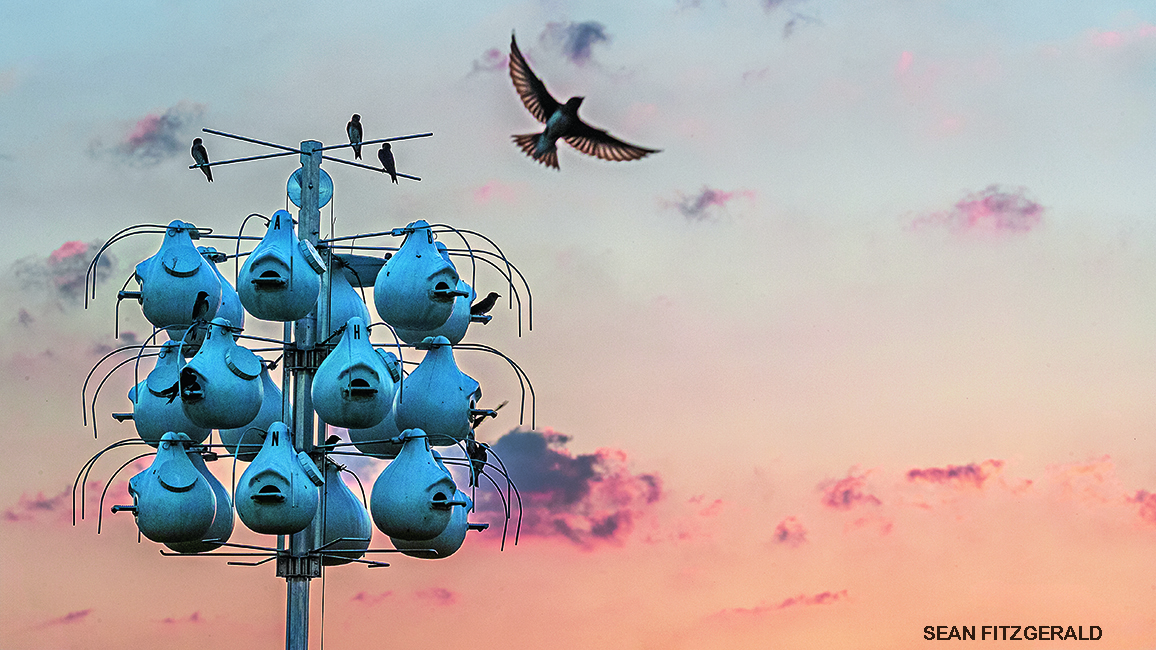
Welcome Mat for Purple Martins
By Ellen Lambeth; Photos by Sean FitzgeraldThese birds need a friendly helping hand. And that’s exactly what they are getting!
The birds in this story are purple martins—the largest species in a family of birds called swallows. Swallows have awesome flying skills. They swoop and swirl toward winged insects. Then they nab them right out of the air! As you can see below, the male martin on the right is darker and glossier than his female mate, perched next to him. And above is proof that purple martins like to nest in
colonies (groups). That high-rise building for birds is called a gourd rack. Each gourd can hold a single nest built by a mated pair of martins.
People who provide such group bird houses are called “purple martin landlords.” Some landlords monitor (keep track of) the birds in their colonies throughout the breeding season. William Ebel (below) is part of a monitoring team in Texas. Here, he’s just lifted an adult male martin from one of the gourds for inspection. The bird is still holding a katydid he caught! Keep reading to see
what else these bird-friendly caretakers are up to!
WELCOMING THE MARTINS
William lives on a ranch with its own martin housing. But in this story, he’s helping to monitor a colony on a nearby ranch. This one belongs to “landlord” Julie Mattox.
Julie’s ranch has several gourd racks. Altogether, they add up to 92 nesting gourds! And each gourd is checked every four days during the breeding season. Good thing, purple martins are cool with all the “nosy” humans hanging around. Julie really appreciates the help from William and other kids in the area. And the kids are proud to play an important role in this huge “community science project.”

FOR THE BIRDS
You may be wondering, “What’s the big deal with these birds?” As with so many wildlife species, there are way fewer purple martins now than before. That’s especially true for martins in the western part of the country. The number of eastern martins has been going down fast, too. They need help! And they’re getting it, thanks to people like Joe Siegrist. Joe was a Ranger Rick reader as a kid, which made him want to grow up to help wildlife. And now that’s exactly what he does—at the Purple Martin Conservation Association.
Joe’s work allows him to share his love of martins with others. He teaches people how they, too, can help. He collects the information that Julie and other purple martin landlords send to him. And that helps him keep track of how the birds do during their breeding season. As you see below, he also sometimes visits successful colonies like Julie’s.

NEW DISCOVERIES
Biologist Anna Forsman teamed up with Joe on this visit to Julie’s colony. She collects health information from the birds. This may help the team discover things that might harm—or help—the purple martin population. Anna also bands the birds. It’s like putting little ID bracelets on their legs. When banded martins show up at other times or in other places, those “bracelets” give Anna, Joe, and other scientists even more information.

What the eastern martins really need is more housing. That’s because they now, for some reason, nest only in human-made structures. The racks in this story even come with built-in protections against predators such as snakes, hawks, or raccoons.
More kids getting involved will make a big difference, too. Joe hopes that, someday, every elementary school in this region will have its own purple martin colony.

So, what are you waiting for? Ask your teacher to visit purplemartin.org and click on the EDUCATION tab. If your school is in the right zone, offer to help host a new colony there. The martins—and Joe—will thank you!


















